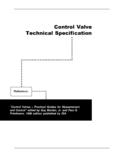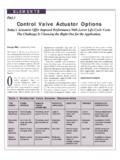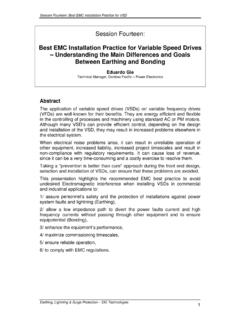Transcription of Proper Grounding of Instrument and Control Systems in ...
1 Session Two: Proper Grounding of Instrument and Control Systems in Hazardous Locations Session Two: Proper Grounding of Instrument and Control Systems in Hazardous Locations Joe Zullo Regional Sales Manager: MTL Americas Introduction Grounding is defined as electrical equipment connected directly to mother earth, or to some conducting body that serves in place of the earth, such as the steel frame of a plant and its earth mat or the hull of a ship or oil drilling platform. Proper Grounding is an essential component for safely and reliably operating electrical Systems . Improper Grounding methodology has the potential to bring disastrous results from both an operational as well as a safety standpoint. There are many different categories and types of Grounding principles. This paper's primary focus is to demonstrate Proper Grounding techniques for low voltage Instrument and Control Systems (IACS) that have been proven safe and reliable when employed in process Control facilities.
2 For the purposes of this paper, IACS. will be defined as Instrument and Control Systems that operate at 50 VDC or less. As an example of a typical plant, some of the accompanying photographs are courtesy of Washington Gas' facilities in the metropolitan District of Colombia, Virginia and Maryland area as shown in Figure 1. Figure 1. Rockville Peak Shaving/Storage Plant Explosion Protection and Hazardous Locations Conference 2009 IDC Technologies 1. Session Two: Proper Grounding of Instrument and Control Systems in Hazardous Locations Types of Grounds Any discussion on Grounding invariably leads to a discussion on the different types of grounds and the corresponding definition of each. However, it is commonly accepted that grounds in the process industry can be broadly classified as either dirty or clean. Please refer to Figure 2 for a comparison of the different grounds. Dirty Grounds Dirty grounds inside the facility are typically those 120 VAC, 220 VAC, 480 VAC power grounds that are associated with high current level switching such as motor Control centers (MCC), lighting, power distribution, and/or grounds corrupted by radio frequencies or electromagnetic interference.
3 Quite often the primary AC power coming into the plant can introduce spikes, surges or brownouts that further erode the cleanliness of the AC ground. Clean Grounds Examples of clean grounds are the DC grounds, usually 24 VDC, that reference the PLC, DCS or metering/ Control system in the plant. Frequently, Control Systems engineers from the major SCADA (Supervisory Control and Data Acquisition) vendors recommend isolating these grounds from power grounds. Other clean grounds are those associated with data and communication busses that, due to the vulnerability of low level CMOS and microprocessor circuits, must be maintained relatively free of noise interference or risk data/communications loss. Structural Grounds These are the grounds which physically and electrically tie the facility together and, quite importantly, complete the circuit to the 0V, ground leg, of the power distribution transformer. Structural grounds can take many forms. In a ship, it is the hull of the ship; on an offshore oil/gas platform, it is the structural steel of the platform.
4 In large petrochemical or pharmaceutical plants, a ground grid or mat is installed under the plant or the welded structural steel of the plant itself becomes the 0V. electrical power ground. In the typical plant, the 0V ground reference is most often a heavy gauge copper wire embedded around the base of the building and tied into ground rods at the corners as well as into the AC ground feeds at critical junctures. Not only does this copper ground create the 0V reference for the plant's electrical system, it becomes part of a possible Faraday cage lightning protection system that will be discussed later. Explosion Protection and Hazardous Locations Conference 2009 IDC Technologies 2. Session Two: Proper Grounding of Instrument and Control Systems in Hazardous Locations Grounding TYPES . MCC. Instrument Mains Supply' Light ing DIRTY'. CC. GROUND. Cable CLEAN' N-E. Shields'. PLC. Systems '. SE Bar PLC' Instrument System'. Structural GROUND. GROUND. Figure 2. Grounding Types Building a Proper Grounding Bed There are two basic elements that are used for IACS Grounding Systems : Grounding Rods and a Grounding Grid.
5 Using a Grounding rod in a Grounding bed system comprises of installing a ground rod (generally by hammering in the rod) into the earth. Grounding rods come in a variety of materials and sizes. The rods typically are made of stainless steel, galvanized steel, copper clad steel, or pure copper all yielding approximately the same lifespan. The rods generally range from to 1 in diameter and from 5ft. to 10ft. in length. The size of the rod will vary depending on the soil conditions (sandy - high soil resistivity, rocky, silty loam - low soil resistivity, etc.) and the equipment available for installing the rods. It is best to contact a Grounding rod manufacturer for help in determining the best rod to use for a given application. The goal of a Grounding rod is to achieve a resistance of 25 ohms or less between the rod's Grounding conductor and the soil in the general vicinity of the rod per NEC 200. The rods are generally installed near the electric utility's meter, in the vicinity of large above ground structures, and are tied in at various locations to the Grounding grid.
6 (see Figure 3). Figure 3. Proper Grounding Bed Explosion Protection and Hazardous Locations Conference 2009 IDC Technologies 3. Session Two: Proper Grounding of Instrument and Control Systems in Hazardous Locations The Grounding grid portion of a Grounding bed consists of burying a bare Grounding conductor around the perimeter and across a station or plant, at a depth of 2 to 4 feet below grade. The cable is #2 AWG (minimum) stranded copper cable. This Grounding grid is then tied into the electric utility's meter's earth ground at a location where the Grounding grid is closest to the electric meter ground. All electrical equipment and instruments and above ground structures susceptible to lightning strikes are connected to this Grounding grid (see Figure 3). Larger above ground structures, such as buildings, will tie into the Grounding grid at multiple locations. It is imperative that in order to construct a premier Grounding bed, the Grounding grid and Grounding rods must be installed deep enough to be in direct contact with conductive earth, not just a wet sandy nonconductive variety of ground.
7 In marshy areas it is not unheard of going to a depth of 30 feet to find conductive soil. Connecting IACS to the Grounding Bed Connecting electrical equipment and IACS to a Grounding bed is called bonding and is done to prevent local potential differences. Local potential differences can be unsafe (causing electric shocks) and can also wreak havoc on IACS, causing them to function improperly, and fail prematurely. The best method to connect the IACS to a Grounding bed is by using cable clamping connectors and heavy gauge (12 AWG minimum) green vinyl clad or bare stranded copper cable. It is preferable to run this Grounding cable along the shortest distance feasible from the Instrument or Control panel star-point's (discussed later). Grounding lug to the Grounding bed, in order to provide the least resistance possible to mother earth. The resistance along the Grounding conductor cable from the IACS to the Grounding bed should be ohm or less. See Figure 4 displaying a Control panel star-point connected to the Grounding conductor.
8 Star-Point l Figure 4. IACS Control Panel Star Point Explosion Protection and Hazardous Locations Conference 2009 IDC Technologies 4. Session Two: Proper Grounding of Instrument and Control Systems in Hazardous Locations What is a Faraday Cage? A Faraday cage acts as a shield against the effects of electromagnetic energy by directing the energy around a structure instead of through it. One can use the Grounding grid cable to create a Faraday cage around a plant's above ground structures in order to provide an easy path for lightning strikes to mother earth. The Faraday cage helps protect personnel from injury and sensitive instruments from damage due to electric shock. Figure 5 demonstrates an example of how to design a Faraday cage around a building. Figure 5. Faraday Cage Star Point Grounding , Single Point Connection Look at the accompanying AC distribution diagram on Figure 6 and appreciate the fact that all the subsystems in the plant, instrumentation, communication, computers and Control , and AC power, are connected to a single point ground system.
9 This is known as star point Grounding . Properly done, each subsystem ground is kept as short as reasonably possible and is connected to the star point at only one point. Multiple paths to the ground plane from a subsystem inherently have different resistances. Different resistances to ground produce, by Ohm's Law, different voltage potentials impressed on the Control system. The net result of not employing star point Grounding is increased vulnerability to transient surge damage as well as less reliable Control system functioning. Explosion Protection and Hazardous Locations Conference 2009 IDC Technologies 5. Session Two: Proper Grounding of Instrument and Control Systems in Hazardous Locations STAR POINT Grounding . Instrumentation Telecoms Computers Single Ground RF. Reference AC Distribution Figure 6. AC Distribution Diagram For IACS Control panel star-point terminal blocks, a corrosion resistant, stainless steel or nickel plated busbar is the heart of a star-point Grounding system as shown in Figure 7.
10 Figure 7. IACS Star-Point Termination Bar How Not to Ground! Do not ground various elements of the IACS , shields from field transmitters and the DCS/PLC power supply ground, to different grounds. Figure 8 shows a prime example of how not to ground. In this example, the Control loop shields are grounded to a separate ground rod. Additionally, the Control element power supply is grounded to the AC ground but the PLC analog input circuit is left floating. Even in a smaller plant, if different instruments are connected to independent ground rods, the reference to ground will vary which will develop localized potential differences. This is a sure recipe for disaster. Explosion Protection and Hazardous Locations Conference 2009 IDC Technologies 6. Session Two: Proper Grounding of Instrument and Control Systems in Hazardous Locations HOW NOT TO GROUND. DC Power Figure 8. The Figure 8 circuit can be remedied by common wiring the field transmitter shields, DC. power supply and the PLC to the same 0V, AC ground point, with as short and as heavy gauge wire as practicable.









